
Also known as the Evergreen State, Washington is home to part of the Pacific Coast Range. It’s the biggest range of temperate rainforests in the world and stretches from Alaska to California. This group of forests includes the Hoh Rain Forest in Olympic National Park, Washington. These forests are perfect for several different snake species, with lots of prey and plenty of hiding places.
Love ‘em or hate ‘em, snakes are everywhere, even as far north as Washington state. There aren’t as many here compared to other states, but you may spot a few in and around Washington’s rivers. And, speaking of rivers, Washington is crisscrossed with nearly 70,000 miles of rivers. That’s a lot to explore!
Very few snakes spend more than a couple of hours per day in the water. In the U.S., the only true watersnakes are those in the Nerodia genus and they don’t occur in Washington. However, Washington has several garter snake species that love the water and even eat fish, frogs, and other amphibians. Additionally, all snakes can swim!
Now, whether an area is snake-infested is largely a personal opinion. If you’re an avid herper (one who loves finding reptiles and amphibians), infested likely means something different than the average person. There aren’t that many snake species in Washington — it’s too far north for most. And, according to iNaturalist.org, the serpents most likely slithering about are garter snakes, racers, and gopher snakes. Over two-thirds of the reported sightings are of one of the three garter snake species!
Let’s look at the waters that seem to have the most snake sightings to identify snake-infested rivers in Washington.
Columbia River
The Columbia River traverses over 1,200 miles from British Columbia, Canada, through Washington and drains into the Pacific Ocean. The long and winding route it takes has ample habitat for Washington’s 12 or so snake species. With stunning vistas that include forests, mountains, and deserts, the river offers plenty of activities like boating, fishing, and hiking — making it popular with locals and tourists alike.
The long length of the Columbia River means you could see most of the state’s snakes somewhere along the river. And, the snakes you find shift from rattlesnakes, gopher snakes, and racers as the river enters Washington in the northeast to predominately garter snakes as it empties into the Pacific Ocean. Other snakes you may encounter along the Columbia River include striped whipsnakes, ring-neck snakes, and sharp-tailed snakes.

Bonneville Dam is one of several along the Columbia River.
©J-B-C/Shutterstock.com
Snake River
This is the biggest tributary flowing into the Columbia River, joining it around Kennewick, Washington. Interestingly, the Snake River’s name didn’t come from the snake population or its meandering shape. No, someone misunderstood the sign language the Shoshone used for weaving baskets. They instead thought it meant “snake,” and it stuck.
The Snake River enters Washington in its southeastern corner. There are northern Pacific rattlesnakes and gopher snakes aplenty – making this one of the most snake-infested rivers in the state.
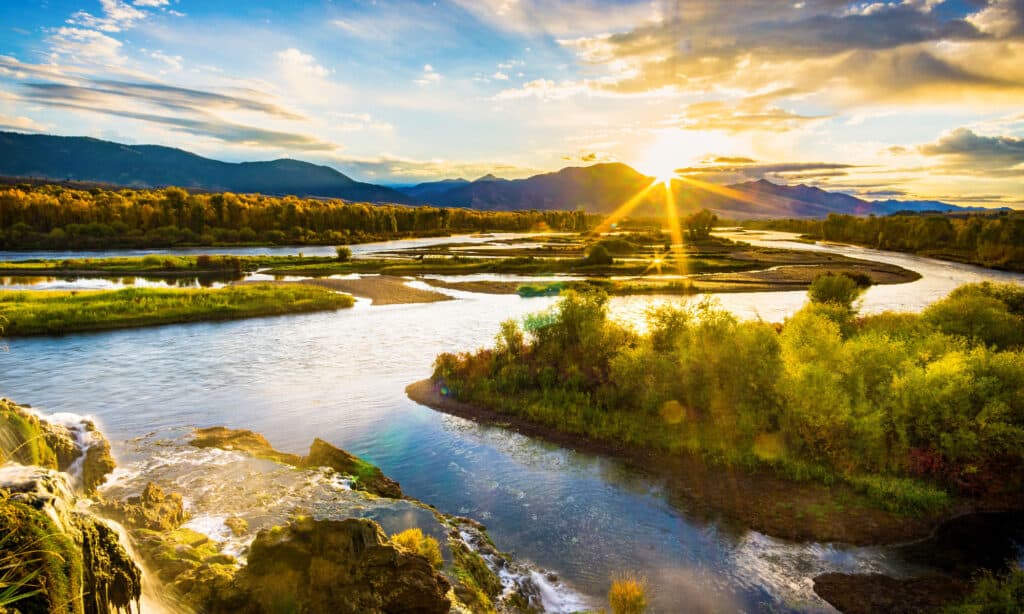
The Snake River flows through Wyoming, Idaho, and Oregon, and joins the Columbia River in Washington.
©Barry Bjork/Shutterstock.com
Skagit River
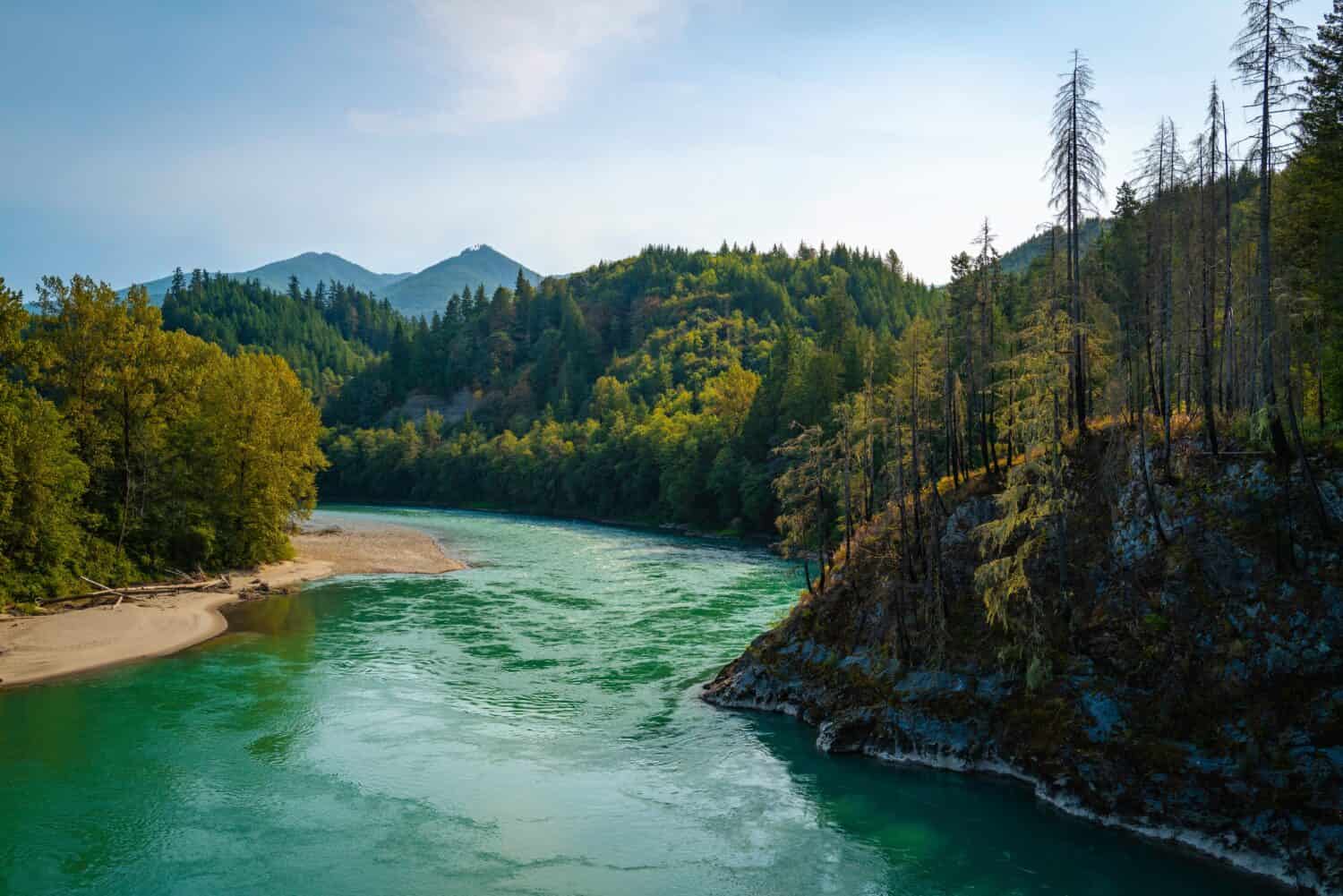
All three of Washington’s garter snake species can be found along the Skagit River.
Image: NayaDadara, Shutterstock
©NayaDadara/Shutterstock.com
The Skagit River runs about 150 miles from its beginning in the Cascades, to its ending at Puget Sound. The river’s floodplain is one of the most ecologically diverse areas in the world. It supports thousands of species including salmon and bald eagles. The area has estuaries and tide flats and supports rich farmland.
The winter weather this far north is too cold for most snakes. So, that leaves you with the nearly unstoppable garter snake. All three of the state’s garter snake species occur along the Skagit River, making it one of the snake-infested rivers in Washington.
Klickitat River
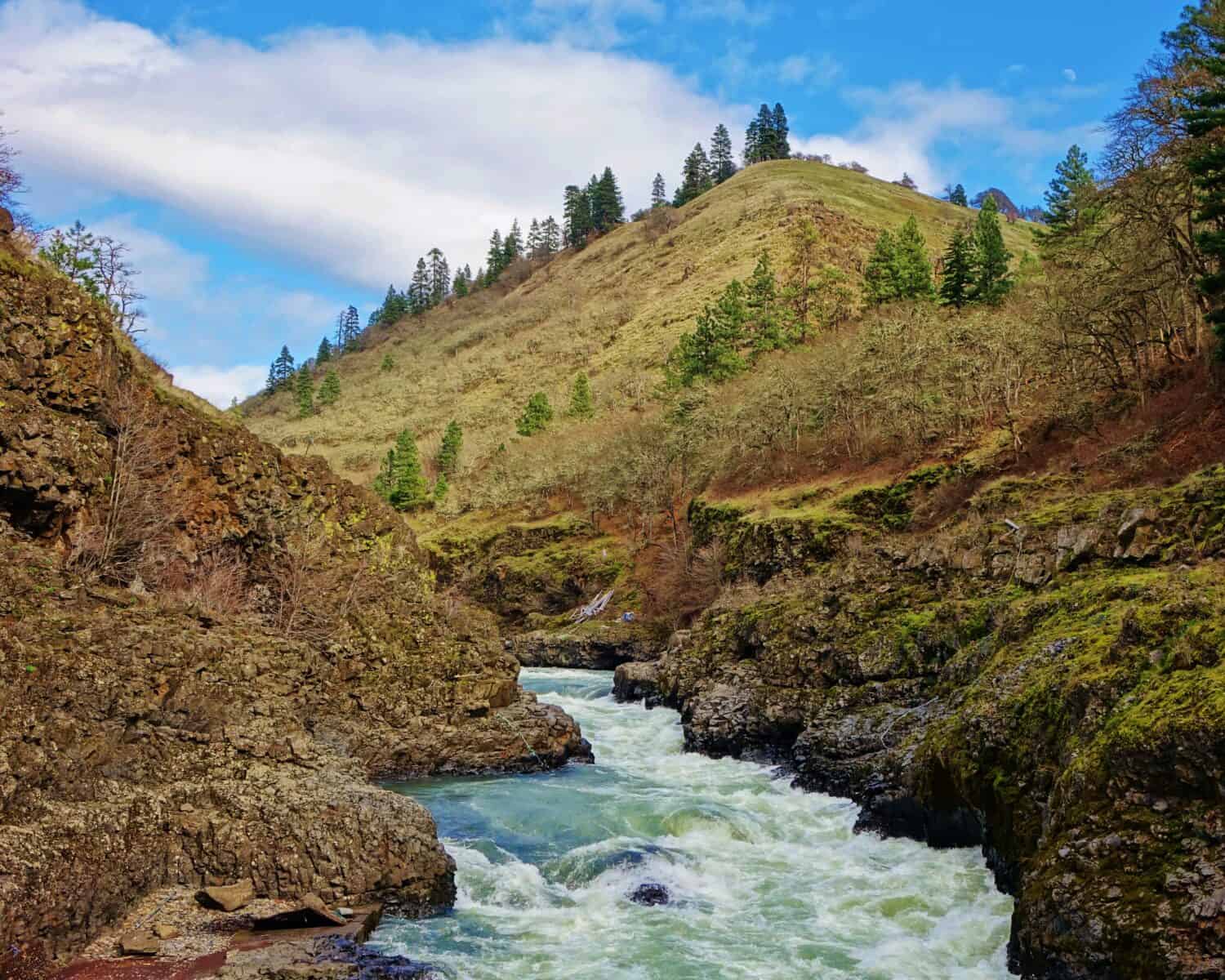
Hikers can follow the Klickitat Trail for 30 miles down the river.
Image: Dan Lewis, Shutterstock
©Dan Lewis/Shutterstock.com
Some could say the Klickitat River is one of the snake-infested rivers in Washington. This tributary flows for about 96 miles from the high Cascades south, joining the Columbia River near Lyle, Washington. Its scenic views meander through steep canyons. For the more adventurous people, the Klickitat Trail follows the river for about 30 miles along an old railroad grade.
This southern river is home to all of the state’s snakes, making it one of the snake-infested rivers in Washington. The most common are gopher snakes, northern Pacific rattlesnakes, and western yellow-bellied racers. If you’re lucky, you might see a northern rubber boa or a sharp-tailed snake too!
Common Snakes
Of all the snakes in North America, garter snakes are the most widespread and cold-tolerant of all our native snakes. They thrive as far north as British Columbia, Canada, are active earlier and later in the year than many species, and are versatile.
Washington State has three native garter snake species, most with a couple of subspecies.
Northwestern Garter Snake (Thamnophis ordinoides)
The most commonly-sighted garter snake around Washington’s lakes is the Northwestern garter snake. This is Washington’s smallest garter snake species; it can get up to four feet long, but most stay a bit smaller.
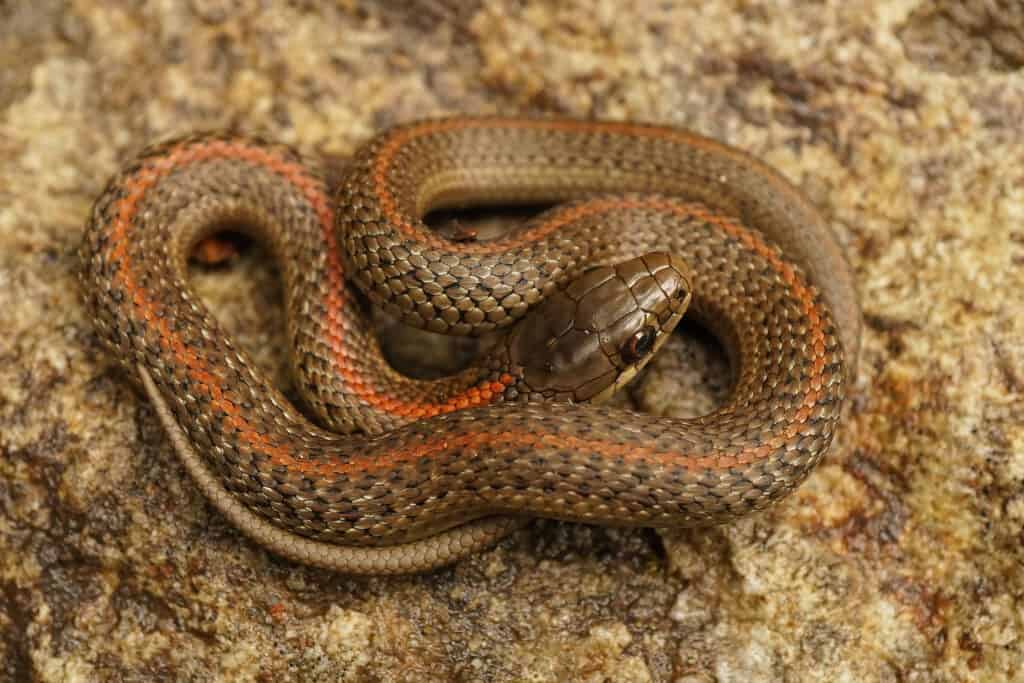
Closeup of a very small juvenile, Northwestern Gartersnake, Thamnophis ordinoides in North California
©HWall/Shutterstock.com
Common Garter Snake (Thamnophis sirtalis ssp.)
This garter snake and all its subspecies are prevalent throughout most areas where snakes can live in North America. There are a few arid regions they avoid, but overall — if there’s a habitat, no matter how meager, there’s a common garter snake.
Common garter snakes come in a rainbow of colors — red, green, brown, black, and blue, to name a few. Almost all of them have stripes down their back and sides, some have checkerboard patterns and others have solid base colors. The three color patterns you’re most likely to see around Washington’s lakes are:
- Red-spotted gartersnake (T. s. concinnus) — southwestern washington.
- Puget Sound Gartersnake (T. s. pickeringii) — Northwestern Washington.
- Possibly the valley Gartersnake (T. s. fitchi) — Rocky mountains.
Garter snakes eat worms, slugs, amphibians, and fish. They prefer moist habitats where they have access to a permanent water source, but are even found in vacant lots.
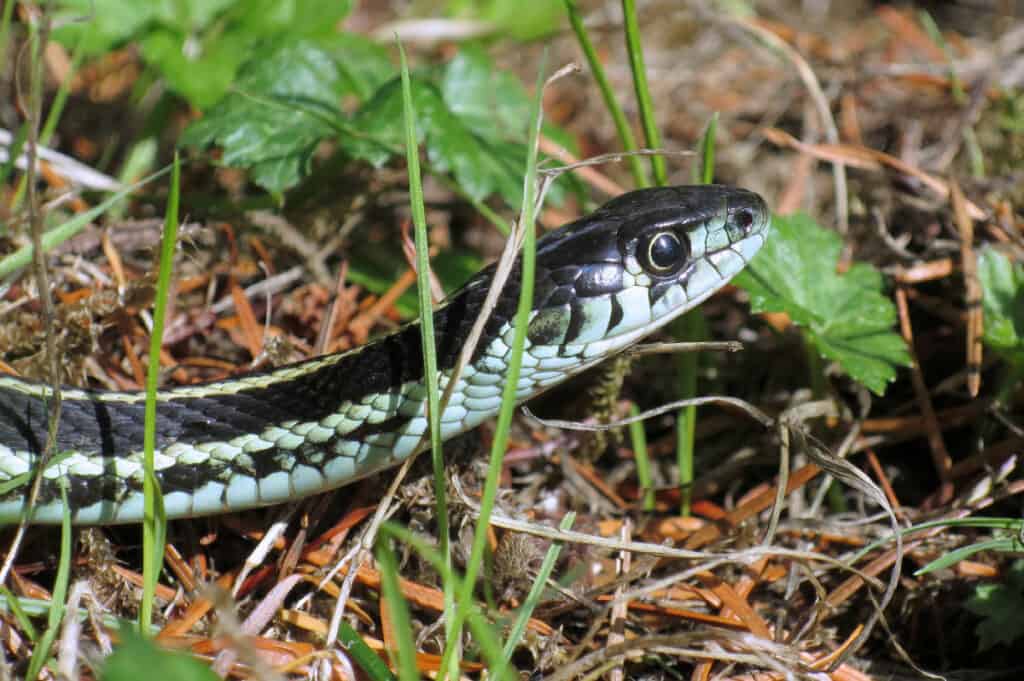
Puget Sound garter snakes are one of three common garter snake subspecies in Washington state.
©iStock.com/randimal
Western Terrestrial Garter Snake (Thamnophis elegans ssp.)
Contrary to its name, this garter snake is almost always found near water. Western terrestrial garter snakes are relatively common throughout Washington and you’re likely to find the wandering garter snake subspecies (T. e. vagrens).
This species grows to about three and a half feet long, has a head that’s slightly wider than its neck, and a strong dorsal stripe that often looks irregular. Like the other garter snakes, it’s known for musking any perceived threat, sometimes biting, and always squirming to escape — but it’s harmless.
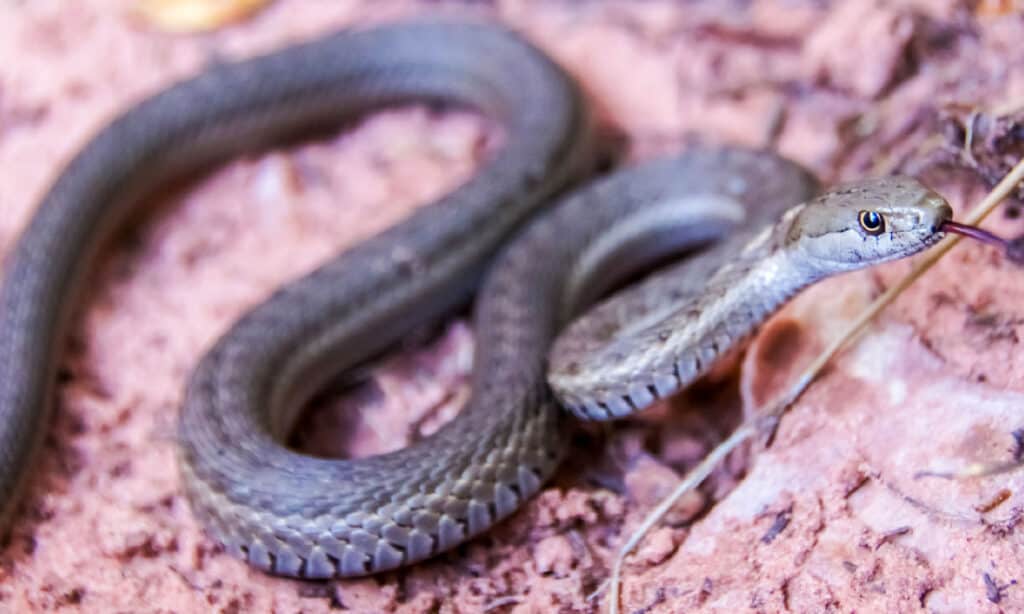
Nearly all western terrestrial garter snakes have three stripes down the length of their bodies — a dorsal stripe and one stripe on either side, just above the belly.
©iStock.com/yhelfman
Gopher Snake (Pituophis catenifer ssp.)
This big, bad, non-venomous faker is pretty common, especially in areas where there are rattlesnakes. You’re most likely to find the Great Basin gopher snake in eastern Washington. Their patterns are often similar to rattlesnakes, and they grow up to seven feet long.
Gopher snakes puff up, hiss loudly, and rattle their tails against the ground to try to chase off threats. However, they’re harmless.
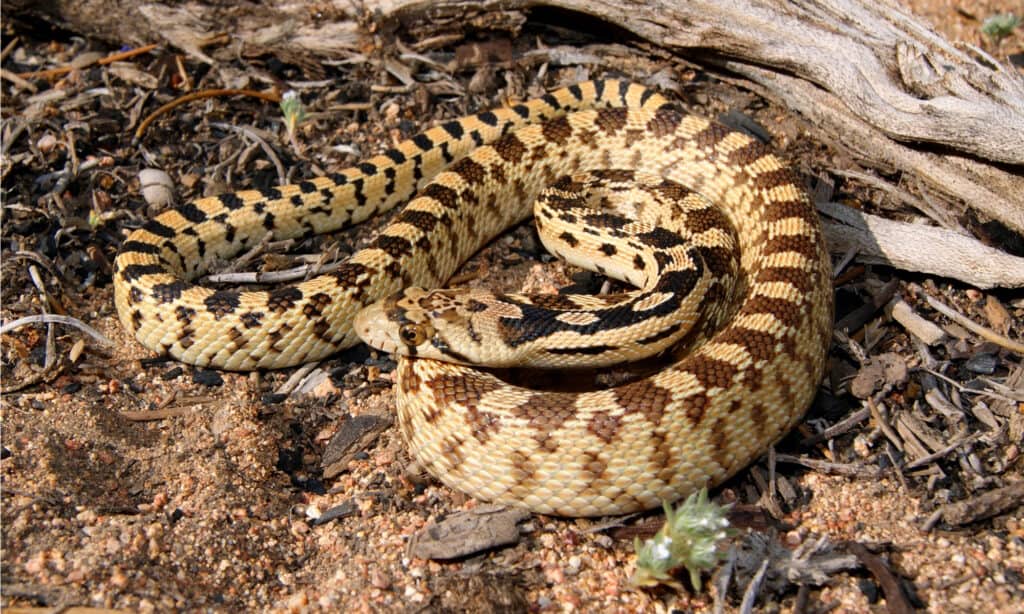
Great Basin Gopher Snake, Pituophis catenifer deserticola
©Matt Jeppson/Shutterstock.com
Venomous Northern Pacific Rattlesnakes in Washington
If you live in Washington, you’re in luck! There’s only one venomous snake in the state. Plus, it’s pretty happy to warn you it’s there — the Northern Pacific Rattlesnake. Sometimes still called the western rattlesnake, this snake is native to the eastern half of Washington, mostly in more arid and forested climates.
All snakes can swim, but not all of them spend much time near the water. Northern Pacific rattlesnakes generally prefer drier habitats. However, if the weather gets too hot or they need to get from point A to point B and the river happens to be in the way, they’ll slither right into the water.
In Washington, most Northern Pacific rattlesnakes stay around three feet long, but if they have enough prey and good weather, a five-footer isn’t uncommon. These snakes have roughly oval-shaped blotches outlined in white on their backs, black and white banding on their tail that ends in a rattle, and the chunky heads many people associate with pit vipers.
Older snakes’ patterns tend to be less bold than juvenile snakes, but they’re pretty easily recognizable. Fortunately, rattlesnakes aren’t aggressive and are more than happy to move away from you, given half a chance.
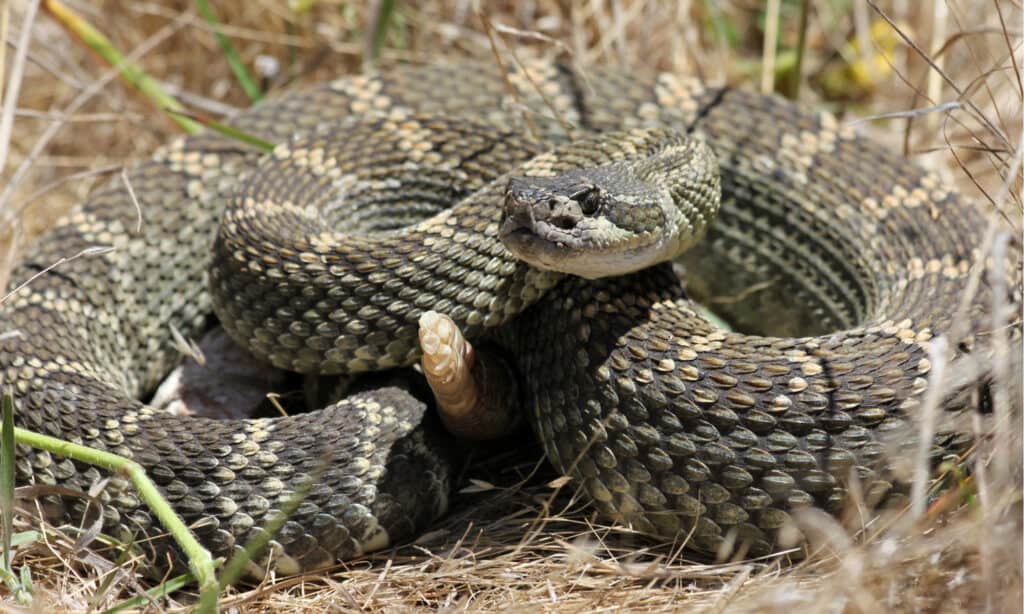
Northern Pacific rattlesnakes are food for almost anything bigger.
©Ryan M. Bolton/Shutterstock.com
Snake-Infested Rivers?
In the end, whether a river or other habitat is “infested with snakes” is largely an opinion. And that’s okay! Most snakes are just as happy to avoid you as they are stoked to evade the avid herper. Getting a solid population count on snakes is almost never possible. It’s always an estimate, based on how many they saw this year versus last year. So, it’s really hard to quantify just how many there are out there.
Complete List of Snakes
Washington only has 12 snake species, and one is extremely rare. Here’s the list:
- Northwestern garter snake (Thamnophis ordinoides)
- Terrestrial garter snake (Thamnophis elegans)
- Wandering garter snake (T. e. vagrens)
- Common garter snake (Thamnophis sirtalis)
- Red-spotted garter snake (T. s. concinnus)
- Puget Sound garter snake (T. s. pickeringii)
- Valley garter snake (T. s. fitchi)
- Great Basin gopher snake (Pituophis catenifer deserticola)
- Sharp-tailed snake (Contia tenuis)
- California mountain kingsnake (Lampropeltis zonata)
- Northern desert nightsnake (Hypsiglena chlorophaea deserticola)
- Ring-neck snake (Diadophis punctatus)
- Western yellow-bellied racer (Coluber constrictor mormon)
- Desert striped whipsnake (Masticophis taeniatus)
- Northern rubber boa (Charina bottae)
- Northern Pacific rattlesnake (Crotalus oreganus)
Summary of the 4 Most Snake-Infested Rivers in Washington State
| River | Snakes | |
|---|---|---|
| 1 | Columbia River | Rattlesnakes, gopher snakes, racers, garter snakes, whipsnakes, ring-neck snakes, and sharp-tailed snakes |
| 2 | Snake River | Northern Pacific rattlesnakes and gopher snakes |
| 3 | Skagit River | Garter snakes |
| 4 | Klickitat River | Gopher snakes, northern Pacific rattlesnakes, western yellow-bellied racers, sharp-tailed snakes, and northern rubber boas |
The photo featured at the top of this post is © iStock.com/JPLDesigns
Discover the "Monster" Snake 5X Bigger than an Anaconda
Every day A-Z Animals sends out some of the most incredible facts in the world from our free newsletter. Want to discover the 10 most beautiful snakes in the world, a "snake island" where you're never more than 3 feet from danger, or a "monster" snake 5X larger than an anaconda? Then sign up right now and you'll start receiving our daily newsletter absolutely free.
Thank you for reading! Have some feedback for us? Contact the AZ Animals editorial team.







